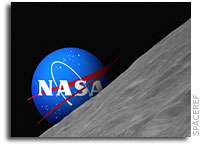NASA Teaming Opportunity to Develop Virtual Sensor and Autonomous Robot Swarms
 Virtual Swarms within a Sensor Network
Virtual Swarms within a Sensor Network
Exploration of remote planetary surfaces has been limited to few humans and singular robotic vehicles thus severely limiting the range and duration of expeditions. NASA has proposed an exploratory airplane for MARS that would extend the range but removes the robot from surface contact and still presents a singular view. A sensor network, a distribution of a large number of connected, capable devices distributed over a region, could extend the range of exploration without the requirement for mobility. Conventional sensor network design is limited to a sense and send scenario where individual devices periodically sense the environment and send information through a multi-hop network of others to the central controller. However, a much more complex mission could be accomplished by a “virtual swarm” over the distribution. While the individual devices remain fixed, the application could move around the network as required to complete the mission. To take full advantage of the architecture and achieve maximum success, the application must adapt to unforeseen circumstances presented by the environment. More
Autonomous Robotic Swarms for Planetary Exploration
NASA has proposed an exploratory airplane for MARS that would extend the range but removes the robot from surface contact and still presents a singular view. A flying swarm of a large number of smaller vehicles, operating autonomously yet cooperatively, could extend the exploration range while maintaining direct surface contact as the swarm “hops” from point to point. Such a design has the added benefit that individual failure would not condemn the mission to fail (e.g., 80% of individuals could fail with 100% mission success). A swarm design presents new problems such as how the swarm will effectively fly in formation and how the swarm will determine course of action. Because much the environment is unknown, the swarm must adapt to unforeseen situations. Centralized control and predetermined script execution is likely not practical. Without directions from a central controller, individual members of the swarm are limited to local observations and communication with neighboring members. From these observations, individuals must make autonomous decisions and take individual action. From these actions, a behavior emerges. Thus, the challenge is to design the swarm for desired emergent behavior. NASA seeks a demonstration of true autonomy in formation flying of a swarm and in decisions on actions of the swarm to complete an exploratory mission. More








